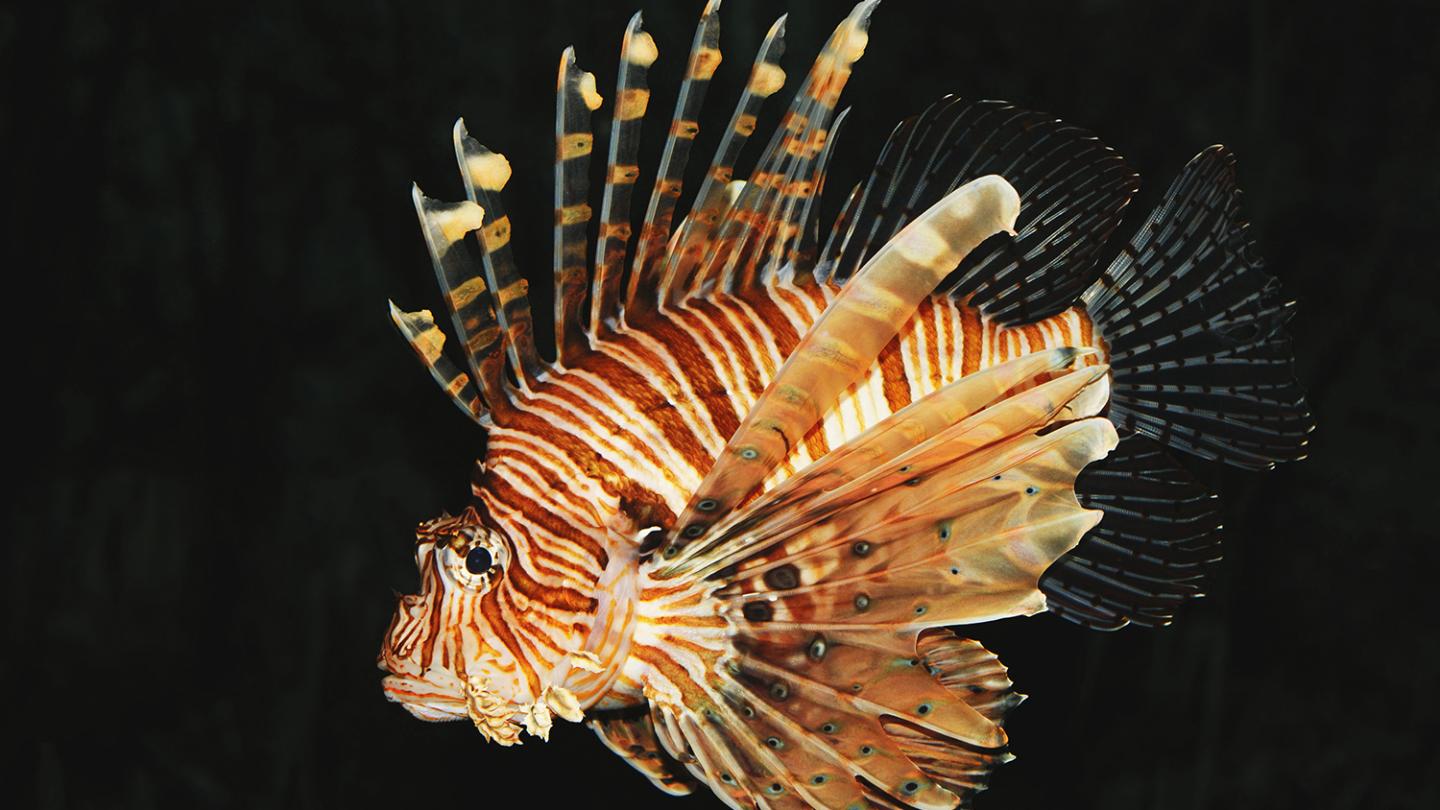
Credit: Photo by Michael Gäbler published under a Creative Commons license.
What makes the red lionfish (Pterois volitans) such a successful and powerful invader in Atlantic Ocean waters compared to its rather lamblike existence in its native Pacific Ocean?
A new North Carolina State University study examining two native lionfish regions in the Pacific and five invading regions in the Atlantic showed the greatest genetic similarities between lionfish in the region of Taiwan and the Bahamas, suggesting a population near Taiwan was the source of the invading species.
Lionfish were introduced to the Atlantic in the mid-1980s, most likely as the result of a marine ornamental aquarium trade. In the Atlantic, P. volitans acts differently from the native Pacific species. Known to be shadowy and furtive in their native Pacific waters, lionfish – freed from Pacific predators – become voracious predators in the Atlantic, responsible for massive reef fish kills, devastating economically important grouper and snapper. Plus, they rival rabbits in procreation.
“P. volitans has a lot going for it in Atlantic waters,” said Martha Burford Reiskind, research assistant professor of applied ecology at NC State and corresponding author of a paper describing the research. “They are found at high densities and in some cases can spawn every four days in the Atlantic; their eggs can travel great distances on ocean currents, exacerbating their spread.
“They are also difficult to handle because of their venomous spines. The population has grown so large that controlling it, not eradicating it, is the primary goal.”
Besides learning more about important gene regions that show evidence of rapid evolution when the species arrived in the invasive range, the researchers also examined whether Atlantic or Pacific lionfish may be hybrids, or combinations, of two lionfish species. Specifically, researchers wanted to know if P. volitans had merged with P. miles, the devil fire fish.
“We didn’t find any evidence of P. miles or hybrids in our Atlantic Ocean samples,” Burford Reiskind said. “But we can’t rule out that the fish introduced to the Atlantic from the Pacific wasn’t already some type of hybrid between an Indian Ocean and a Pacific Ocean species.”
Burford Reiskind said that the study could help during other invasive events.
“Some of these invaders rapidly adapt to new surroundings. What are the genes that allow them to successfully invade?” she asked. “Can we make better predictions so that invasive species like P. volitans are eradicated before it’s too late?”
The research was conducted by undergraduate and graduate students in a conservation genetics course taught by Burford Reiskind. In this experiential-leaning project, students collected samples, sequenced DNA, built genomic libraries, analyzed data and served as co-authors of a paper that appears in Biological Invasions.
“We weren’t sure what we were going to find when we took on this project as a class,” Burford Reiskind said. “It was fun to see the students learn how to conduct genomic studies on an important conservation question.”
###
The research was supported by a Dean’s Enrichment Grant from NC State’s College of Agriculture and Life Sciences.
Note to editors: An abstract of the paper follows.
“The genomics of invasion: characterization of red lionfish (Pterois volitans) populations from the native and introduced ranges”
Authors: Martha Burford Reiskind, E.M.X. Reed, A. Elias, J.J. Giacomini, A.F. McNear, J. Nieuwsma, G.A. Parker, R.B. Roberts, R.E. Rossi, C.N. Stephenson, J.L. Stevens, B.E. Williams, North Carolina State University
Published: Online April 13, 2019 in Biological Invasions
DOI: 10.1007/s10530-019-01992-0
Abstract: Invasive species are one of the greatest threats to global biodiversity and ecosystem health, and population genetics provides promising tools for understanding the evolutionary process of successful invaders. The well-documented introduction of the red lionfish (Pterois volitans) to the western Atlantic, Gulf of Mexico and Caribbean has decimated native fauna due to the invader’s voracious predation and growth rate. We tested whether our samples were within the region of the source of invasion into the Atlantic and Caribbean and investigated whether hybridization in the native or introduced range was responsible for the success of this invasive species. We used a reduced representation sequencing method to generate over 50,000 single nucleotide polymorphisms and sequence data from two mitochondrial DNA genes to analyze the population patterns. We found one location in the southeastern Pacific that was genetically similar to one location the southwestern Atlantic and evidence of the subsequent spread south to the Gulf of Mexico and the Caribbean, which supports previous findings. Within the native range, we found genetic divergences commensurate with distinct species and evidence of hybridization. We found limited structure within the introduced range and no evidence of Pterois miles or hybrids within this range. Finally, we found signatures of selection between the native and introduced range that may be a result of the introduction. Overall, this study of the red lionfish showed the pattern of introduction and suggested a deeper sampling of genomic data from individuals within the native range may reveal hybridization between species as the source of the aggressive invasion.
Media Contact
Martha Burford Reiskind
[email protected]
Original Source
https:/
Related Journal Article
http://dx.




